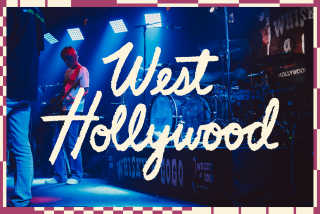The Envelope: Robert Elswit’s two sides of L.A. in ‘Inherent Vice,’ ‘Nightcrawler’
L.A. native Robert Elswit captures profoundly contrasting visions of the city as cinematographer for two films this season. “Inherent Vice,” directed by Paul Thomas Anderson, brings back the funky, freewheeling 1970s South Bay beach towns with their sunny, psychedelic, anything-goes vibe. “Nightcrawler,” written and directed by Dan Gilroy, presents a city alive at night, with its freeways and feral fringe-dwellers, and a lonely, media-driven, vapor-lighted vastness that lacks a center — moral or otherwise.
Elswit’s collaborations with Anderson include “Boogie Nights,” “Magnolia” and “There Will Be Blood” (which brought him an Oscar); he also happens to be godfather to actor Jake Gyllenhaal, who stars in “Nightcrawler.” We talked with Elswit about his vision of the two L.A.s.
You grew up in Los Angeles in the 1960s and ‘70s and went to USC’s film school. Did you spend much time in the beach towns?
Yes, a lot. I lived in Venice in my college years and went to parties up and down the coast, from Hermosa Beach to Malibu. It was relatively cheap to live there then, and very open and crazy. There was always something going down. It was completely wild. I feel great nostalgia for that time and place.
Snapshots from the ‘70s have such a specific look, based on the color film and how it faded. How did you go about capturing the feel of that time and place?
Paul was really chasing that look — at one point, we even shot on some old Kodak film stock from that era, but it didn’t work out very well. We looked at still photos of bands shot in Laurel Canyon and the Sunset Strip area, and amateur photos shot on color slide film that we found in picture books that chronicled the beach towns. We were going for an oceany sunlight, a low-contrast, soft-quality image like a faded photograph, so we did things like shoot into windows, which lowers the contrast. It was absolutely the opposite of “Nightcrawler,” which has a very hard-edged, high-contrast look with bright, popping colors.
You’ve said you strongly prefer shooting on motion picture film, but on “Nightcrawler,” you shot the nocturnal outdoor scenes on a digital system. Why?
We used the Alexa, which is an Arri digital camera, because it allows you to shoot with low levels of ambient, available light from things like storefront neon or street lamps or police cars. We could get vivid, bright, exaggerated colors, reds and greens and oranges — the opposite of a black-and-white film noir look.
Can you talk about the significance of some of the key locations in “Nightcrawler”?
It’s Danny Gilroy’s Los Angeles — seen from the edges, the wicked underbelly, the Valley when the sun goes down and there’s no “there” there, nothing architecturally interesting, no charm, just this endless sprawl that all looks the same. That’s why the movie takes place on the roads and freeways — they’re the connective tissue, so you see them in almost every shot, if only at the edges or the background.
How about the recurring image of Mt. Wilson seen silhouetted at night?
It’s emblematic of the way the media extends itself into Los Angeles, with all those antennas sticking up. We see that Lou [Gyllenhaal] is stealing cable TV and it all emanates from this giant hilltop antenna system, and he’s a product of this information he gets from his TV and Internet that teaches him how to behave as a human being.
And that dismal-looking Echo Park apartment?
Danny wanted to put him up in the hills looking toward downtown in a relatively low-rent area with strong imagery different from what you see in most movies about Los Angeles. The people we found living in those apartments were kids out of college, two or three to an apartment, mostly friendly stoners with jobs in media making video games. It was kind of wonderful — it reminded me of living in Venice and Santa Monica when I got out of school.
More to Read
From the Oscars to the Emmys.
Get the Envelope newsletter for exclusive awards season coverage, behind-the-scenes stories from the Envelope podcast and columnist Glenn Whipp’s must-read analysis.
You may occasionally receive promotional content from the Los Angeles Times.







